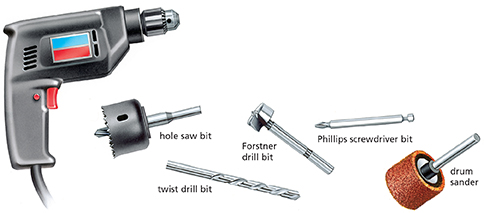9.2 Substituted Hydrocarbons
Reading Focus
Key Concepts
 What functional groups are found in alcohols, organic acids, and organic bases?
What functional groups are found in alcohols, organic acids, and organic bases?
 How are esters formed?
How are esters formed?
Vocabulary
substituted hydrocarbon
functional group
Reading Strategy
Monitoring Your Understanding Copy the table. As you read, complete the table by connecting each functional group with the type of compound that contains the functional group.
Functional Group |
Type of Compound |
|---|---|
-OH |
a. |
-COOH |
b. |
NH2 |
c. |
The electric drill in Figure 10 can be used to drill holes, tighten a screw, or sand a rough surface. To change the function of the drill, you replace, or substitute, an attachment. A carbon atom in an organic compound can have four attachments. In a methane molecule (CH4), the carbon atom has four identical attachments—its hydrogen atoms. When methane reacts with chlorine, chlorine atoms replace hydrogen atoms.
Chloromethane and hydrogen chloride are products of the reaction between methane and chlorine. So are compounds with two, three, or four chlorine atoms. Organic compounds containing chlorine or other halogens are halocarbons. Almost all the halocarbons found on Earth were released from refrigerators, air conditioners, or aerosol sprays. Researchers have established that halocarbons containing chlorine and fluorine deplete Earth's protective ozone layer. The manufacture of chlorofluorocarbons has been restricted since 1990.
A hydrocarbon in which one or more hydrogen atoms have been replaced by an atom or group of atoms is a substituted hydrocarbon. The substituted atom or group of atoms is called a functional group because it determines the properties of the compound. Alcohols, organic acids, organic bases, and esters are substituted hydrocarbons.
Figure 10 Hydrocarbons in which some hydrogen atoms have been replaced can be compared to an electric drill with attachments.
Inferring What determines the function of the drill, the drill itself or the attachments?






